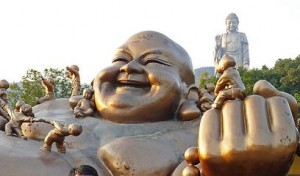Was the Buddha’s physiognomy superhuman, or simply deformed? The extreme literal-mindedness of a new thesis on the thirty-two marks of a mahā-puruṣa bodes well for the author’s future career in Buddhist Studies:
It is plausible that the observation of most of these thirty-two uncommon physical attributes might well have been accumulated over centuries as a result of contact by observers with various afflicted persons.
A bit too much information follows:
We expect to be able to determine the plausibility of his physical variations based on current data available for congenital abnormalities, such as connective tissue disorders (Ehlers-Danlos and Marfan’s syndrome) to explain his skeletal features (his long reach, long digits and legs, pedal deformity), and acquired physical changes as with endocrinopathies, as one might see with acromegaly (large tongue and jaw) and Cushing’s syndrome (interscapular hump, soft skin, hair growth quality).
Here’s the citation — for completists only:
Bendz, Oleg. The Buddhalakshana. M. A. thesis, University of Toronto, 2010. [abstract / PDF]


